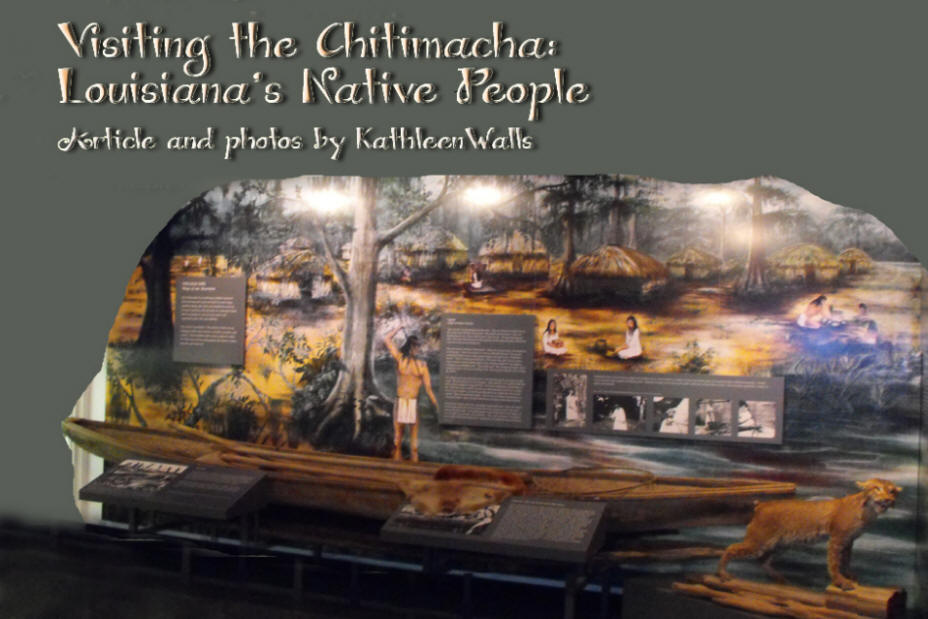|

Few native Americans managed to retain
their ancestral lands so when I visited the Chitimacha Museum in
Charenton, Louisiana and found that the Chitimacha still
retained some of their original homelands in Louisiana, I was
intrigued and wanted to learn more about these little known
people. Tahra Demarco, Museum Services Specialist, led us
through the museum and was willing to tell us about her people.
 |
| An exhibit of the beautiful
basketry of the Chitimacha |
The museum is small but has a lot of information about current
tribal activates and past history. A key item seen in the museum
is the beautiful baskets which have become so valuable. The few
weavers that still retain the knowledge have long waiting lists
for their baskets. She
explained that the basket weaving of the Chitimacha was one of
their most prized skills. Over the years it was almost lost. A
very few of the elders of the tribe still retain the ancient
knowledge and are currently giving classes to younger tribe
members. The first task that the students must master is the
harvesting, drying of the river canes and splitting them into
the strips to make the baskets. If they cannot master this, they
go on farther. If they can. they can go on to carry on a proud
native tradition. Present chief, John Paul Dawden, his wife,
Scarlett, and his sister Melissa Darden, are some of the skilled
men and women who have mastered the art of basket weaving. Each
basket is unique and tells a story of the Chitimacha people. If
you see a red straw woven into the hem of each basket it means
it was created by a
weaver from the Darden family. To Melissa, the craft is very
important. &"I feel
that this is a way of preserving the natural history of my
culture."
 |
 |
|
Some examples of Chitimacha culture: a tribal chief,
clothing and artifacts |
A recent project to preserve the culture is the Rosetta Stone
Software language project which enables tribal members to learn
Sitimaxa, their native language.
The museum tells so much of the
traditional history of the people. their costumes and customs
are preserved here. Near the entrance you face a replica of
Chief Framboise who greets you with the words, "Caqaad kaskec
name qaxt xahyte," meaning "Welcome to the bend in the bayou."
 |
| Scot McCue, Cypress Bayou Casino
executive chef |
An ancient dugout 27 feet, 4 1/2 inches long holds a place of
honor high on the wall and is one of the oldest artifacts here,
dating back about 500 years. Living in swampy St. Mary Parish on
the Atchafalaya Basin of Louisiana, dugouts were an important
part of Chitimacha life. In fact they called themselves "the
people of the waters."
A visit to the museum is a walk through
time. However, like all cultures, the Chitimacha while striving
to preserve the heritage of their ancestors are planted firmly
in the 21st century. In addition to the museum, they invite you
to visit their Cypress Bayou Casino and Hotel.
We dined at Cafe Bayou, one of seven
dining spots at the casino. The slots were tempting me but the
food was calling even louder. I had the Shrimp Arcadiana, a
delicious concoction of six huge shrimp baked in a crabmeat
dressing and topped with mozzarella cheese. It came with fries
and native style corn. Scot
McCue, Cypress Bayou Casino executive chef, visited with us
while we ate. He came to the casino from Tucson, Arizona and is
not a native Chitimacha but he said he feels like "they have
adopted me."
(For more about Cajun dining click here)
This is a unique slice of Louisiana they
you should not miss.
For more info:
http://www.chitimacha.gov/attractions-accommodations/museum
|
![]() Ads fund American Roads so please consider them for your needed
purchases.
If you enjoy the articles we offer, donations
are always welcome.
Ads fund American Roads so please consider them for your needed
purchases.
If you enjoy the articles we offer, donations
are always welcome.
----------
|